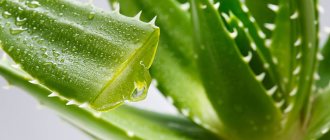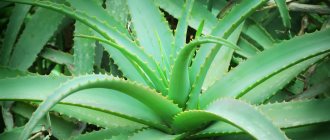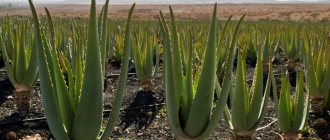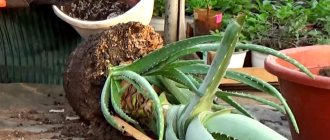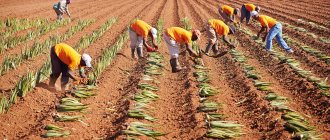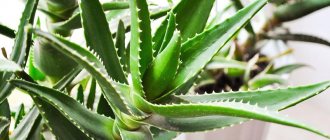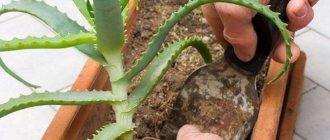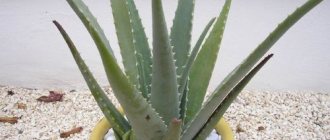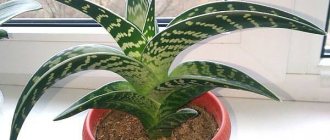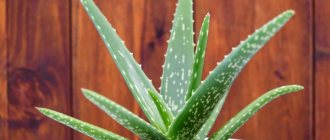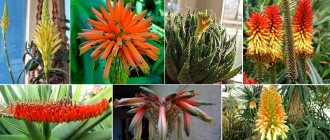What kind of pot is needed for Aloe
Aloe is a good medicine that is convenient to grow at home. Can help with cuts and chronic diseases. What is the convenience of keeping a plant at home? The fact is that aloe is easy to care for and does not need abundant watering. In winter no more than once a month, in summer a little more often.
Care after transplant
Aloe, although not demanding, requires appropriate care. The dominant rate is related to the order of watering. A lack of water for this cactus is a better option than a generous overflow. In a damp container, the greens will begin to rot.
How to water, lighting and temperature
Weekly sprinkling is sufficient for the plant, provided that the specimen is not very old. For an adult cactus, the frequency of sprinkling should be infrequent. An adult specimen can be watered twice a month in the summer, once every 40 days in the winter, and once every thirty days in the fall.
Lighting for agave should be intense. For aloe, a southern windowsill is recommended. When there is insufficient light, the leaves of the plant become distorted and the bush itself grows uneven.
Important! If the flower has been on the north side for quite a long time, it should not be suddenly moved into bright sunlight.
The temperature regime for aloe can be fully adjusted – 12-30 degrees. In the summer months, it is good to move the plant to an outdoor flower bed or to an unglazed loggia. Indoors, it is important to regulate the amount of watering depending on the temperature. The warmer it is, the more water the cactus will need.
Aloe is a cactus species found in nature in a variety of forms. Only about 500 different plants grow in Africa, as well as the Arabian Peninsula. The common Russian name for Aloe is agave. The medicinal properties of this plant were known more than three thousand years ago. For example, the plant is widely recommended in gastroenterology, ophthalmology, and for long-healing wounds and ulcers.
Suitcase Lacase, Plastic, 60 cm, 50 l
8883 ₽ More details
Suitcase Lacase, Plastic, 60 cm, 50 l
2799 ₽ More details
Women's winter shoes
Which pot is suitable for aloe
It is recommended to plant and replant the plant in the spring, since the aloe has already faded. The first transplant is carried out after a year, subsequently the period increases to once every 2-3 years. Aloe Vera has a fibrous root system. The root shoots resemble a cone shape - the roots are long cylindrical in shape.
The plant collects moisture at the tips of its roots, which means it needs to be watered not in a pot, but closer to the roots - in a tray. It is necessary to take into account these features so as not to make a mistake and the aloe does not die.
Features of choice
In stores you can find pots made of plastic or clay. There is no right choice of material.
Therefore, it is worth talking about the pros and cons of the proposed options. Plastic: lightweight and cheap pots that do not break if dropped, but often crack if handled carelessly. It is easy to make additional holes if the existing ones are not enough for the flower to exist comfortably.
Clay: the walls of such a container have a porous structure and do not contribute to the stagnation of moisture (therefore, the flower will need to be watered more often); the walls also withstand the attack of hot sunlight and protect aloe roots from high temperatures. Durable in use, unlike its plastic competitor.
You should not plant the flower in a large container, as this promotes the formation of alkali. If you allow a high concentration in the soil, the roots will begin to rot.
Important! There should be 1-2 cm of free space between the roots, walls of the pot and its bottom.
It is worth paying attention to the crown of the flower. The size of the container should be 2 times smaller than the diameter of the plant (the gap between the opposite aloe leaves).
Let's summarize. When choosing a pot, you must comply with the following conditions: 1. The presence of drainage holes at the bottom. 2. When replanting a plant, pay attention to the previous container: the volume should increase by at least 3 cm. 3. If the root system is wide, then you will need a pot with a much larger diameter. 4. If the roots grow deeper, then a higher pot is needed.
Source
Preparing for landing
Let's consider the main ways to prepare the selected material for planting. Before sowing, aloe seeds are treated with potassium permanganate to disinfect them. To prepare the solution, use 0.5 liters of pure water and potassium permanganate on the tip of a knife, stir the mixture thoroughly until it acquires a light pink tint. Soaking lasts 20 minutes, then the seeds are washed under running water and dried.
When using different parts of a flower for planting, they are pre-treated for better rooting:
- When growing aloe from a cutting, it is cut into pieces 10 cm in length and all sections are sprinkled with crushed charcoal. The treated parts are left on a napkin at room temperature for several days so that they dry well;
- when cutting the top from an old plant, they retain a length of 12 cm . The cut is treated with charcoal and left to dry for a couple of days, the same as in the case of cuttings;
- Growing aloe from leaves also requires preliminary preparation of planting material. A young aloe leaf is used as a suitable material for planting; its length should be at least 8 cm. It is cut off at the base and treated with crushed coal. Leave the leaf in a warm place so that a thick film can form on the cut - this process can take from 2 days to several weeks.
Did you know? The healing properties of aloe appear only in the 5th year of the plant’s life.
Optimal growing conditions
Aloe, like any other indoor plant, requires special conditions for normal growth and development.
First of all, you should choose a suitable place to install a flower pot, guided by the following recommendations:
- Aloe is a light-loving plant; when placed in full shade, it can lose its decorative effect: its stems become very elongated. That is why it is better to install the pot on a western or eastern window. You can place the pot on a south-facing window, but be sure to shade it from direct sunlight to avoid brown burns.
- The air temperature in the room in summer should be at +18...+25°C, and in winter, so that the plant does not suffer from the cold - not lower than +14°C.
- The air humidity in the room is not particularly important for aloe; it can be anything, but it is worth noting that artificially increasing the humidity by spraying the leaves with a spray bottle can cause them to rot.
Selection of capacity
Aloe can be grown in plastic or heavy ceramic pots. They must have a sufficient number of holes at the bottom so that excess liquid freely leaves the pot, and the root system does not suffer from excess moisture. The size of the container is usually chosen in accordance with the size of the plant that is being planted.
Important! Clay dishes are usually not used for growing aloe, as they tend to evaporate moisture through the walls.
The pot should be low, but wide enough. For small plants that are planted without a root system, in the hope that they will soon take root, a pot of 8 cm in diameter is suitable. When the aloe has taken root well, after 1 year, it is transplanted into a pot of larger diameter, choosing the size in accordance with the volume of the root system, usually leaving 3 cm of free space on the sides.
Soil preparation
You can plant aloe in purchased soil (for succulent plants) or make it yourself by mixing different components: washed river sand, clay and humus. All ingredients are taken in equal parts, mixed thoroughly and disinfected in a double boiler for 2 hours. Thanks to this treatment, all harmful microorganisms and fungal spores can be destroyed. The resulting soil retains sufficient looseness and breathability.
Important! After steam treatment, the soil mixture should stand for a while, at least a week, so that a sufficient number of beneficial microorganisms that affect the normal functioning of the plant root system are restored.
Method for planting aloe at home
A particularly popular method of planting aloe at home is propagation by shoots (sprouts) without roots, which allows you to get a large number of new flowers from one plant.
From a sheet
When the cut aloe leaf has dried well, you can start planting:
- A little expanded clay is poured into the selected container (which has holes at the bottom) and filled with earth mixture.
- Aloe leaf is dipped in Kornevin to stimulate root formation.
- A small depression is made in the soil and the prepared leaf is placed vertically, cut down, so that it sinks into the hole by at least 5 cm.
- Fill the hole with soil, lightly compacting it to secure the planting material.
- Lightly moisten the soil surface with warm water from a spray bottle.
- Cover the container with a transparent jar to create a greenhouse effect and quick rooting.
Cuttings
After the cuttings have dried, they can be planted:
- Clean, damp river sand is poured into a long container.
- Make small depressions (2 cm deep) in the sand, maintaining a distance of 5 cm between them.
- Cuttings are placed in the prepared holes, dipping the lower part in “Kornevin”, and covered with sand, lightly tamping to fix the planting material in a vertical position.
- The sand is kept moist until the plant takes root.
- After the first roots begin to grow, after waiting 1 week for them to become slightly stronger, each cutting is transplanted into a separate container with a substrate for succulents. Expanded clay and soil are poured into the bottom of 7 cm (diameter) pots and cuttings with roots are planted.
Video: planting aloe cuttings
Tops
Let's look at how to plant the top correctly:
- Wet river sand is poured into a small container.
- Make a hole in the sand, 5 cm deep.
- The lower part of the planting material is dipped in Kornevin and placed in the hole.
- Fill the hole with sand, lightly tamping it down to fix the top.
- Since the flowability of sand can disrupt the stability of the plant, it is recommended to fix the top with a peg, which is buried as much as possible in the sand.
- When the plant takes root, it is necessary to transplant it into a substrate, as is the case with cuttings.
Find out what aloe soil you can use at home and how to make your own soil mixture.
Seeds
To grow aloe from seeds you need:
- Prepare the soil mixture for sowing: mix 1 part leaf soil, 1 part turf soil and 0.5 parts sand.
- Pour the prepared soil into a long rectangular container and make shallow (1 cm) furrows.
- Seeds treated with potassium permanganate should be sown at a distance of 3-4 cm from each other.
- Soil is poured over the seeds so that all the seed material is covered with soil.
- It is recommended to cover the container with plastic film to create optimal conditions for seed germination.
- Every day the film should be removed for 1 hour, and when the seeds germinate, remove it completely.
- When the seedlings have grown sufficiently and are 5 cm in height, it is time to plant them in separate containers with a diameter of 6 cm, leaving the soil composition the same.
- Expanded clay is placed at the bottom of the pots, the soil mixture is poured and each plant is planted in the center of the pot, then watered.
Video: planting aloe seeds
How to plant aloe at home? Rules for transplanting aloe
It is unknown how and when this plant came to our region, who and for what purpose placed it on their window, or rather, in the winter garden. Perhaps history has preserved such information, but few people are interested in it, and the strange-looking plant took root, settled on the kitchen window and became part of our everyday life, some call it aloe, and others call it agave.
Tree aloe or aloe vera is grown much more often than other species, of which there are more than 300. Unpretentious, like any succulent, it is ready for the most incredible tests and its survival rate is simply fantastic.
How to choose?
The main criterion that determines the choice of aloe variety is the preferences of its owner (namely, for what purposes he intends to use the purchased succulent - medicinal or decorative). If we highlight the requirements that the leaves of the plant of interest to the grower must meet, then their list will look like this:
- fleshiness and elasticity;
- rich color;
- no damage.
The choice of aloe cuttings used as planting material is also worthy of attention. This part of the succulent must have sufficient length (at least 5 cm) and strong, fleshy leaves (at least 2-3 pieces).
Planting material
We are used to buying houseplants we like in a specialized store already in a pot, often already mature and flowering, but we most often find aloe from friends and relatives, in a casual conversation over a cup of tea, we learn a lot of interesting things about the properties of the plant, about who from friends and what exactly was cured with this plant - and we take a piece or baby from the mother plant.
Baby
The easiest way to plant is a young plant, of which there are many growing from the mother bush at its very base. The young aloe is fully formed and its root system is ready for independent life, but is located on the surface of the soil, as if waiting to be transplanted into its own pot. Small plants are called babies, and planting them is the easiest and most reliable option.
Upper part of the stem
The part of the stem that is well suited for propagation is the apex, with two or three pairs of leaves. She should have a strong, healthy appearance. There is no need to plant it right away; let it sit for 5 or 6 days, heal its wounds on its own, and the damaged areas should dry out. However, you can also dip the cuttings in water until roots form. There is information about possible rotting instead of root formation, but in my many years of practice this has not happened, the roots sprouted, the young plants lived in ordinary water for about six months, were transplanted into pots and took root normally
Didn't manage to get hold of a baby or cuttings? It doesn’t matter, a leaf is enough, you need to pick it as close to the mother plant as possible, the smaller the tearing area, the faster the leaf will let go of its roots. There is no need to rush with planting; let it sit for a week, heal the wound, and prepare for planting.
Seeds
This method of propagating aloe is also possible, but it is usually used by succulent collectors to grow decorative, variegated species. You will learn all the details about the propagation and cultivation of aloe here.
Which pot should you choose?
Ceramic pot
The best for any plant is a simple ceramic pot.
The clay from which it is made is a natural material, such a pot allows the root system to breathe, regulates soil moisture well, looks decent in any interior, and lasts a long time without losing its appearance. And their range is varied, from simple to elegant and very elegant, but all this is secondary, their environmental friendliness comes first.
Plastic pot A plastic pot
has become a worthy replacement for a ceramic pot; flowers grow in it, and the price is much lower. Children's plastic buckets are a thing of the past; they have been replaced by a wide variety of plastic flower containers in shape, color and size. And for lovers of the classics, of course, pots and pots in the color of ceramics, but made of plastic, are suitable.
However, plastic pots have some disadvantages: they do not allow air and moisture to pass through, the soil needs to be loosened, drainage is especially important and the amount at the bottom of the pot should be at least one quarter of the volume.
How to plant without roots?
All plants, without exception, need care, attention and love, each of your pets has their own preferences, aloe needs care no less than others. If everything in his life is good, he will delight you with flowers; at first glance, they are modest, but they appear completely unexpectedly at the end of winter, and the color scheme of these small bells is so harmonious that it is impossible not to admire them. You can read about aloe flowering in this article.
The plant does not need frequent watering , you need to water it no more than once every 2 weeks. You can replace watering with spraying, the main thing is not to forget to loosen after watering.
How to replant at home?
The plant is actively growing, is the pot becoming too crowded?
Buy a container that is freer; there should be three or five centimeters of open ground left from its edge to the lower leaves; replanting is carried out according to the same rules as planting. Both autumn and winter are suitable for planting and replanting. Agave or aloe - like a symbol of home comfort and well-being, lives in every home, with very rare exceptions. And even though it itself cannot live for a whole century, everyone has known its healing qualities for a long time. Maybe it was the desire to live 100 years thanks to this healing plant that gave it the name by which it is known among the people.
See more photos of aloe:
What conditions are needed for regular flowering?
The flowering period of aloe vera occurs in the spring, in early or mid-March. The first inflorescences appear on a young plant only 4 years after planting. Then, if you follow all the rules for caring for the succulent, it can bloom every year.
Blooming peduncle.
Aloe needs to be prepared in advance for the flowering period. With the onset of winter, it must be moved to a cool but well-lit room. The air temperature should be from +10 to +12 ⁰С. Since the succulent comes from hot and sunny countries, it also really needs light in winter. If there is not enough natural light, fluorescent lamps can be used to illuminate the aloe.
Aloe should be watered rarely in winter, approximately once a month. Before watering, you need to check whether the soil has had time to dry. At the same time, you should not overdry the soil too much. You also need to monitor the humidity in the room. It should not be high, otherwise the succulent’s roots may begin to deteriorate.
After the onset of warm weather, more than +10 ⁰С, aloe should be periodically taken out into fresh air. Gardeners recommend first exposing the succulent to the sun for one hour, gradually increasing the time. Then the plant can be left on the balcony for the whole day, taking it indoors only at night. In summer, if the air temperature does not drop much, aloe can be completely moved outside.
During the period of bud formation, aloe needs cool air, but when the inflorescence begins to bloom, the succulent needs to be moved to a warm room. It is desirable that the temperature be between 21 and 30 ⁰C. The minimum temperature at night should not be lower than 15 ⁰C.
The frequency of watering also changes during the flowering period. If in normal times the succulent is watered once a month, then when a flower appears, this should be done approximately once a week
At the same time, it is very important to prevent the soil from becoming waterlogged, otherwise the roots may begin to rot, which will lead to the death of the plant.
When watering the plant, you don’t have to worry that water will get on the leaves - aloe is not afraid of this.
When aloe flowers begin to fall off, the peduncle needs to be cut off at the root. If this is not done in time, it will deplete the plant.
Aloe vera fruits rarely form at home. They set fruit only through cross-pollination, which is almost impossible to ensure at home.
How to plant aloe correctly at home
This plant belongs to the category of succulents. Therefore, aloe prefers well-lit window sills and easily tolerates a lack of moisture, as it accumulates it in its leaves with rare watering. If the basic requirements of the culture are met, this plant will not cause any trouble.
Aloe is rightfully considered a home healer.
Note! For its full development, it is important to plant correctly. This procedure includes several main steps. Therefore, it is worth familiarizing yourself with them in advance.
What time of year is it better to plant and is it possible in winter?
It is best to plant aloe, like other indoor plants, in late February - early March. It is during this period that the plant emerges from the state of winter dormancy and biological processes intensify.
If it was not possible to plant during this period, then you can postpone the procedure until the end of summer, namely until July-August. At this time, sap flow in the tissues of the plant increases, so it easily tolerates planting and quickly recovers
Important! Planting aloe in late autumn, as well as at the beginning and middle of winter, is not recommended, since at this time the plant is in the dormant stage and will not be able to fully take root, which means it will die.
What kind of soil is needed for aloe
In nature, this plant can be found in countries with arid climates and soil poor in nutrients. At the same time, aloe feels great in such conditions and grows well. Therefore, it is necessary to prepare soil for it, the composition of which will be as close as possible to its natural habitat.
You can purchase a ready-made substrate at a flower shop, choosing a soil mixture for cacti and succulents. But you can also prepare suitable soil for aloe yourself. The main thing is that the substrate is loose, light and well-drained.
To plant aloe you will need to mix the following components:
Important! Peat should not be added to the soil, as it increases acidity, and this has a depressing effect on the roots of the plant.
The soil for aloe should not be nutritious, the main thing is that moisture does not stagnate in it.
In what container is aloe grown: pot sizes
The root system of aloe, like all succulents, is small, but the leaves are fleshy and large, since they contain a supply of moisture and nutrients. Therefore, it is necessary to select not too deep, but wide pots for the plant. When planted in high containers, the plant will constantly turn over.
The diameter of the pot should be selected depending on the age of the seedling
At the initial stage of growth, the width of the planting container should be within 8-9 cm. With subsequent transplants, it can be increased by 2-3 cm.
For your information! You cannot immediately plant aloe in a container that is too large, as the excess soil in the pot will begin to turn sour and cause root rot.
Rules for transplanting aloe
You need to know how to properly transplant aloe so that the plant feels comfortable. To do this, take into account the size of the plant, its age and other nuances.
How to transplant an adult plant into another pot?
A novice owner should familiarize himself with the rules on how to transplant aloe into another pot so that it quickly takes root. To begin, select a suitable pot and prepare the substrate. If the rhizome grows to the sides, you will need a wider container; if it grows downwards, a deeper one. Next you need to follow a few simple steps:
- pour a small earthen pillow into the new pot;
- carefully remove the plant from the old container, being careful not to damage the roots;
- place it in a new pot and add soil to the sides.
You may need to add some soil after a few days as it compacts. In a new container, the plant is left in the shade for a week, watered only after 5 days. Then it is transferred to a well-lit windowsill or balcony.
How to separate and plant a shoot?
The most common way of propagating aloe is by shoots, or babies. They appear every year under the mother bush and already have their own roots. You need to know a few nuances on how to transplant an aloe shoot so as not to harm the adult plant:
- a small bush is carefully dug out of the ground so as not to damage the roots;
- immediately transplant it into a separate pot;
- Water the plant moderately every few days.
This is the easiest way to transplant aloe. In this way, the plant can reproduce all year round, but it is better to wait until the warm season. This plant can produce a large number of babies per season. Many owners complain that their flowers multiply too intensively, and their pots take up all the free surfaces.
Transplantation by cuttings
Aloe can propagate by cuttings. They are shoots that extend from the main stem. The procedure is simple and can be carried out at any time of the year:
- the process is cut with a knife as close to its base as possible;
- the cut needs to be dried before planting, so the sprout is left in the shade for 5 days;
- without waiting for the roots to appear, the cuttings must be planted in the ground to a depth of several centimeters;
- The plant is watered immediately after planting, and then after it has taken root.
You can plant several cuttings at the same time in one large container. In this case, the distance between flowers should be at least 5 cm.
Transplantation without roots
If the flower grows too tall, you can separate the top and form a separate plant. The lower leaves are immediately used to obtain juice or gel, which are then added to cosmetics and medicines. The transplant procedure is very simple:
- the top with 6-7 leaves is cut off with a knife;
- the shoot is placed in a jar of water and waited until it takes root;
- the plant is planted in a pot with a suitable substrate.
The method of replanting aloe without roots is suitable for large adult plants. The leaves become suitable for medicinal purposes at 3-4 years of age, then they are cut off. As a result, the flower turns out to be tall, and the leaves are located only at its top.
How to properly plant aloe in a pot
Before you start planting, you need to prepare everything in advance so that everything is at hand during the procedure. For this you will need:
When everything is prepared, you can proceed directly to planting aloe. It is important to follow the procedure and strictly adhere to the recommendations.
Note! When planting, the aloe root collar should be at or slightly above the soil surface, which will eliminate the possibility of stem rotting.
As soon as the seedling begins to grow, it must be placed on a sunny windowsill. In the future, it is necessary to water the planted plant as the top layer of soil dries out.
How to grow aloe from a shoot without roots
Sometimes the question arises of how to plant aloe if the shoot is without a root. It is quite possible to grow a plant in this case if you act correctly.
This situation may arise in the following cases:
Important! Since aloe is a succulent, it is not recommended to root the shoot in water, as it can rot, so it is better to plant it directly in the soil.
Are there any chances of success?
Before planting a cutting without roots, it is necessary to refresh the cut and leave it to dry for 2-3 days in a shaded place. During this time, a kind of film is formed that protects against infection from penetrating the plant tissue and prevents excessive evaporation of moisture.
Rooting of the shoot occurs within 3-4 weeks
In the meantime, it is necessary to prepare special soil for the aloe shoot. In this case, you need to mix turf soil and river sand in a ratio of 1:2. Heat it in the oven for 15 minutes. at a temperature of 100 °C to disinfect.
To plant the shoot, you can use a plastic glass, make drainage holes in it, lay expanded clay on the bottom in a layer of 2 cm, and fill the remaining 2/3 of the volume with the prepared substrate and moisten it. After this, plant the shoot, deepening it into the soil until the first pair of leaves. Then compact the soil at the base and sprinkle the surface with small pebbles. This will strengthen the seedling and prevent it from falling.
For complete rooting, it is necessary to move the container with the cuttings to a bright place with a temperature of 23-25 ° C, and the plant should not be exposed to direct sunlight. Periodically it is necessary to moisten the soil, observing the rule - it is better to underwater than to overwater.
If the entire procedure was carried out correctly, the shoot will take root without any problems. This can be determined by the new leaves that begin to appear at the top.
For your information! A month after rooting, the shoot must be transplanted into suitable soil and pot.
How to propagate by shoots?
Often, an adult aloe grows shoots, which are called children, appendages. They are basal shoots with their own autonomous root system. Young children take away nutrition from the mother plant, thereby weakening it
That's why it's so important to replant them. Propagation by shoots is a natural method that makes it possible to immediately obtain a young plant
This method involves separating the children from the mother bush and replanting them in the ground. It allows you to grow several young aloe bushes at once. Usually it is combined with transplanting the mother bush, so as not to disturb the plant again.
First, the children are selected and separated in the following sequence:
First of all, you need to moisten the soil well;
take the pot, tilt it slightly and carefully remove the aloe from it;
then inspect the root system and find out the level of development of the roots of the children - you need to take shoots with well-developed roots.
Next you need to separate the children
This can be done with your hands, carefully releasing the roots of the shoots, while trying not to damage the mother root system. If this fails, then you have to make cuts with a sharp instrument.
The cut areas must be sprinkled with charcoal powder.
The separated babies should be allowed to dry for several days.
After this, they begin planting the shoots.
- The bottom of the prepared bowl is covered with a layer of drainage, and the soil mixture is poured on top and moistened.
- 30 minutes after watering, having removed excess water, you can plant the appendages. They are deepened into the soil to the lower first leaves (about 1 cm). The soil is slightly compacted.
- During the first 10 days, the shoots need to be watered every day. Then watering is reduced. Rooting usually takes about a month. Soon new leaves appear on the young aloe.
Sometimes it happens that a young shoot breaks off and remains without a root. But even he can regrow roots.
How to grow aloe from a leaf
This method of growing an aloe vera seedling or other type of crop at home is more labor-intensive.
For rooting, it is necessary to use the lower leaves from a plant older than 3 years. They must be fully developed and have good turgor. The leaves need to be cut off at the base with a sharp knife and placed in a shaded, dry place to form a protective film for 2-3 days.
Rooting should be carried out in clean sand, which should be calcined in the oven in advance. For planting, you need to choose wide bowls with drainage holes to drain excess water. It is necessary to fill them with prepared sand and moisten it evenly. The leaves need to be buried 3 cm in the sand, and the container with seedlings should be placed in a warm, bright place with an air temperature of 23-25 °C.
Important! To grow aloe from a leaf, as well as from a shoot, it is not necessary to create a greenhouse effect during rooting, as this leads to rotting.
If all recommendations are followed, after 1.5-2 months small sprouts should appear at the base of the leaves. Throughout this period, the sand in the container must be kept slightly moist.
Leaf propagation requires patience
It is necessary to plant young seedlings in separate containers when their leaves grow to 3-5 cm. In this case, you need to take a full-fledged substrate as for adult plants.
Knowing how to grow aloe from a leaf, you can get a large amount of planting material. This propagation method allows you to preserve all the specific qualities of the mother plant, which cannot be achieved if you germinate seedlings from seeds.
Flowering and dormant period of aloe vera
In the natural environment, aloe vera blooms twice a year - in spring and autumn. Often this period lasts about six months. In a temperate climate, you can forget about the annual flowering of a succulent; at home, it may not bloom at all.
The dormant period continues during the cold season. It is recommended to take it to a cooler place so that the succulent can regain its strength. If the plant has flowered, it is worth removing the peduncle before the seeds form.
Propagation of Barbados aloe
Propagating a plant is as easy as caring for it. Most often, the propagation procedure is carried out by cuttings. There are other methods with a higher level of complexity.
Cuttings
This method is most often chosen for planting, as it is easier. The leaf cutting should be separated from the mother plant and kept in a dark room for 1 to 2 weeks. During this time, it will have time to dry out, which will increase the chances of its successful rooting in the future.
Harvesting cuttings
The lower part of the cutting is deepened into a pre-prepared substrate by 3-4 cm, waiting for the roots to appear. Root formation occurs slowly. During this time, the leaf may rot. His condition is constantly monitored.
Growing from seeds
There are other ways to propagate a flower. In this case, they wait 2 years until the succulent acquires a decorative appearance. Not all purchased seeds germinate evenly. The method is relevant when the listed disadvantages do not bother the grower.
For planting, it is recommended to choose the time from late January to early March, since during this same period the plant begins to germinate in its natural environment. Before sowing, the seeds must undergo scarification: their protective shell is damaged using fine-grained sandpaper to improve the germination process.
After this, the planting material is placed on a cloth and filled with water; seedlings appear within a week. The presence of roots indicates that the seeds can be planted. They are sprinkled on top of the soil, and a small amount of river sand is covered on top. After this, the soil is sprayed with a spray bottle and placed in a greenhouse until the first petals appear.
Caring for aloe at home after planting
A planted plant needs quality care. Any mistake by the grower at this stage of growing aloe can be disastrous, since the plant has not yet had time to get stronger. Therefore, attention should be paid to the basic requirements of culture, which cannot be ignored.
How to feed aloe
This plant does not require high levels of nutrients. For feeding, you should use mineral fertilizers, which can be purchased at the store labeled “for succulents.”
Aloe rarely needs to be fertilized.
Features of fertilizing:
Important! You cannot use aloe for medicinal purposes after feeding; in this case, you need to wait 2 months.
How to water correctly so as not to destroy young plants
Aloe does not tolerate waterlogging of the soil. Therefore, you need to water the plant only when necessary when the top layer of soil dries out, avoiding stagnation of moisture. It is also important to periodically loosen the soil in the pot to improve its breathability.
For humidification, it is recommended to use settled water at room temperature. Watering should be carried out at the root so that water does not fall on the leaves. But it is also permissible to sometimes pour water into the pan to saturate the substrate with moisture.
When choosing aloe as a houseplant, planting and caring for it at home will not cause any serious difficulties. Therefore, any gardener can cope with this task, regardless of his experience.
Transplanting adult plants
Young seedlings, seeded plants or adult aloe are transplanted in the same way - the only difference is in the size of the planting container.
An adult bush should be replanted when the roots have completely filled the flowerpot; the plant brought from the store is left to acclimatize for 19-21 days, and only then is it replanted.
Aloe transplant
20-24 hours before transplanting an adult plant, water the soil in the pot generously. It is best to replant this flower together. Carefully remove the aloe from the container, lightly shake off the soil and determine by looking at the state of the root system which new pot should be taken by volume. Drainage material is placed at the bottom of the new container; it should fill the pot by about 1/5. A layer of soil 2-3 cm thick is poured on top. The transplanted perennial is placed in a container, holding it suspended so that the roots do not touch the soil layer and do not bend, and the base of the plant is about a couple of cm below the top of the container. Soil is carefully poured into the container , compacting it lightly layer by layer
In this case, it is better for one to hold the plant, and for the other to pour soil into the pot. Then the transplanted bush is watered. When watering, you need to make sure that moisture does not fall on the foliage and does not accumulate inside the outlet - this can serve as an impetus for the plant to rot. After transplanting, it is better to put the plants in a shaded place for several days so that they acclimatize better and faster.
Transshipment
- The plant is removed from the pot along with a lump of earth.
- Without removing the old soil, place the lump on the drainage layer in a new container.
- Add new soil around the root system and compact it a little.
- After transshipment, unlike replanting, the plant is watered abundantly.
Possible problems during landing and immediately after it
Often, planting and propagation of aloe occurs without any difficulties. But sometimes gardeners complain that this succulent does not take root. Therefore, you should find out why this happens.
The most common cause of plant death is excessive soil moisture, which is associated with improper watering. To correct the situation, you need to remove the plant from the pot and clean out the rotten areas and roots with a knife. After this, sprinkle the fresh wounds with charcoal and dry for several days in a dark place.
Then plant in a substrate consisting of sand and turf in equal proportions. The plant should not be watered for the next 2 weeks. If during this time the rotting process does not resume, then the soil in the pot can be slightly moistened. As soon as the plant fully strengthens and begins to grow, it needs to be transplanted into a full-fledged substrate.
Mealybug is a dangerous pest of succulents
Another reason why aloe does not take root may be mealybugs. This pest lays eggs in the roots of the plant. As a result, the emerging larvae feed on the sap of the plant, which prevents rooting. In this case, it is recommended to water the plant with a solution of the drug Aktar (1.4 g per 6 l). After a week, spray the plant and soil in the pot with phytoverm.
Note! Treatments should be carried out until the pest is completely destroyed, alternating medications.
What to do if it doesn’t take root
If, despite all the efforts expended, aloe still cannot fully take root, you need to check whether all recommendations are followed. When planting and growing, everything matters, so even the smallest details should not be ignored.
Most often, the plant cannot fully take root, since the temperature regime during the rooting period is not observed. In this case, it is recommended to repeat the planting, replacing the entire soil. You should also wash the pot well and scald it with boiling water.
Growing aloe, like other succulents, is not difficult; the main thing is to provide the plant with conditions that are as close as possible to its requirements. First of all, this concerns planting, since future development depends on this. Otherwise, even an inexperienced gardener can cope with caring for aloe.
Source
Replanting a succulent
Aloe is replanted in spring or in the first half of summer. At this time, biological processes are activated. The plant recovers faster from a traumatic procedure and gets used to the new soil more easily.
Sometimes the plant does not take root in the new container. There are several reasons:
- The soil is not suitable, the leaves turn yellow. You need to prepare a different substrate or buy a soil mixture in the store.
- An infection has developed or the roots are damaged. The agave is taken out of the pot and the root is treated accordingly. They also replace the substrate and wash the pot with potassium permanganate.
- Violation of the regime of watering or feeding the plant. In this case, the errors made are eliminated.
Important. Despite the fact that aloe is undemanding in care, it is better not to touch it in winter and late autumn. This is a time of rest when all organs recover more slowly. Therefore, stress is less tolerated, which can cause the culture to die.
How often should pots be changed?
After transplantation, the plant rejuvenates and restores its decorative appearance, and soil aeration improves. Aloe grows quite quickly. Therefore, plants up to five years old are replanted every year. Then the rate of development slows down, and the procedure is carried out once every three years.
A transplant is also required in the following cases:
- many shoots formed around the mother bush,
- the container is so small that the roots come out through the drainage holes,
- the soil has become depleted, as indicated by slower growth and death of the lower leaves of the bush,
- the substrate in the container has turned sour,
- the rhizome is affected by rot.
Aloe blooms under natural conditions. But this rarely happens when grown indoors. But if, nevertheless, a tropical inhabitant pleases with a unique phenomenon (usually this happens in winter), then they wait until the flowers wither to replant. Exceptions are made only for emergency situations when it comes to the survival of the agave.
A properly selected pot, a suitable substrate and minimal watering are the key to the health of the agave. Aloe will generously thank the owner for this with its luxurious appearance and healing power.
Features of planting and growing aloe
Aloe belongs to the genus of succulents. This perennial plant comes from the dry regions of Africa. It is grown as an ornamental foliage and medicinal pot crop.
Caring for a flower is limited to creating the conditions under which it grows in the wild. Features of the growth of an inhabitant of the hottest corners of the earth:
In summer, the agave can be taken out into the fresh air, but it must be protected from precipitation.
Plant root system
Aloe has a fibrous root system, the shoots are long and cylindrical. The roots grow downward in a small cone. The older the specimen, the more powerful the underground organs.
The roots of all succulents are adapted to seek moisture even after light rain or heavy dew. In aloe, the areas responsible for water absorption are located at the tips of the roots. Therefore, it is better to water the flower in a tray.
Aftercare for indoor plants
In summer, the flower actively grows green mass, so it needs regular watering. For normal growth of aloe, it is enough to water it once a week - it will accumulate enough moisture in the leaves, which it will gradually consume. In winter, the plant stops growing, so watering is limited by adding water to the pot once every 2-3 weeks.
Water for irrigation is used at room temperature. It is better to water the aloe not at the root, but by immersing the pot in a bath of water for 10 minutes. The flower also needs fertilizing, which is applied every month, except in winter. Mineral fertilizers for succulents, which are used according to the instructions on the package, are well suited as fertilizers.
Did you know? In Japan, aloe is an everyday food product; its juice is added to drinks, and pieces of the plant are a popular topping for yogurts.
Which pot should you choose?
When planning to move aloe into a new container, you need to know the requirements for the size of the pot. If the container is too large, the soil will leach out, the roots will rot, and the plant will stop developing. Pay attention to the material from which the pot is made.
How to choose the right size?
There are several ways to determine the optimal pot size. It should be such that there is 1–2 cm of free space between the straightened roots and the walls and bottom of the vessel.
The required dimensions are also determined by the crown. A correctly selected container has a diameter that is 2 times smaller than the distance between the edges of opposing leaves. The older the plant, the more powerful its root. That's why they take more pot each time.
Another way to avoid making a mistake with your choice is to compare new and old containers. The diameter should increase by 3 cm.
Material selection
Pots are made of plastic and clay. Each material has its pros and cons. Plastic products have the following advantages:
The advantage of a clay pot is that the water in it does not stagnate for a long time due to the porous structure of the walls. Thanks to this, the roots do not heat up and do not rot even under the scorching rays of the sun. More weight gives stability, which the plastic counterpart does not have.
How to properly plant aloe in a new pot
A successfully selected pot size is only part of a successful flower transplant. You need to know what to prepare the substrate from. After all, aloe grows in arid regions where the soil has little moisture but a lot of iron. And we need to try to create conditions for him that are close to natural. Only then will the tropical guest feel comfortable.
Soil preparation
In order for a flower to actively develop, it needs a substrate for succulents. Only in it the leaves grow large and fleshy. This is important because it is in this part that the medicinal properties of the agave are concentrated.
Conditions similar to natural ones are created using turf or deciduous soil, taken in a ratio of 2 to 1. Also add 1 part of coarse river sand and humus. The soil should be loose, with good drainage, and medium to low acidity (pH 6.5–7).
It is also necessary to ensure sufficient air flow to the rhizome. To do this, leavening agents are added to the substrate: charcoal, gravel, perlite, vermiculite, crushed brick. Before planting, the pot is filled in the following sequence:
How to plant a plant
Before planting, wash the container thoroughly with soap. The ceramic pot is calcined and treated inside with a superphosphate solution. Aloe is transplanted according to the following algorithm:
Aloe can be planted by cuttings and top shoots:
The root shoots are planted in the same way, but they are deepened into the sand by 3–4 cm.
